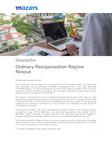
Ordinary Reorganization Regime Rescue
The purpose of the Insolvency Law is to enable companies to face economic crises. When the rules that make up the legal system fall short it is necessary to issue others, as is the case of Decree 560 of 2020, which arises from the limitation that the bankruptcy law has in its margin of coverage, giving capacity to the chambers of commerce to be able to reach more effectively the vast majority of municipalities in Colombia.
The provisions set forth in the Decree are applicable to debtors subject to the Insolvency Regime provided for in Law 1116 of 2006, that is, to natural and legal persons not excluded from the application thereof, branches of foreign companies and autonomous patrimonies engaged in business activities that have been affected by the business crisis generated by the Covid-19.
The Decree intends the creation of broad and inclusive business recovery mechanisms, to facilitate the preservation of the company and consequently for the preservation of employment. It is valid for two (2) years and is based on the following 4 pillars:
1. Creation of expeditious extra-judicial negotiation tools.
2. Creation of extraordinary rescue mechanisms to protect the company, employment and credit, employment and credit.
3. Tax benefits.
4. Suspension of legal norms and obligations.
New is pillar number 1, which creates two types of extrajudicial procedures: (1) emergency negotiation of reorganization agreements, (2) business recovery procedure in the Chambers of Commerce.
Emergency Negotiation of Reorganization Agreements
Contained in Article 8 of the Decree, through this process debtors may negotiate their obligations with a specific category of creditors or with several if so required. In all cases the priority established in article 31 of Law 1116 of 2006 must be respected. It is carried out at the Superintendence of Corporations, the duration of this negotiation is three (3) months, its purpose is to create the proper scenario to reach an agreement without the intervention of a judge and its effects are the suspension of executive or coercive collection processes that are advanced against it and the extension of the payment of obligations for administration expenses that it deems necessary, excluding salaries, parafiscal or social security contributions, which will not constitute default, but the payment of these obligations must be made within the month following the confirmation of the agreement or failure of the negotiation.
Once this stage is completed, the bankruptcy judge will confirm the agreement, which must meet the requirements established in Law 1116 of 2006. If the agreement fails or is not confirmed, the debtor may resort to the ordinary reorganization proceeding.
Corporate Reorganization Procedure in Chambers of Commerce
Article 9 of the Decree establishes this complementary mechanism to the corporate reorganization regime, which may be carried out through the chambers of commerce and their conciliation centers. With the accompaniment of an expert called mediator, the resolution of controversies between debtor and creditor is sought in order to achieve the direct negotiation of the credits in the term of three (3) months, with the suspension of the above-mentioned executive or coercive collection processes. What the mediator does is to help the businessman to mediate the differences in the agreement with its creditors, without having the power to negotiate within the same agreement.
Once the agreement has been obtained, it must be validated by the Superintendence of Corporations or the civil judge of the circuit, depending on the case, so that it may be opposable to the absent or dissenting creditors and be able to resolve their objections and differences, which are called "inconformities", which may be presented before a sole arbitrator who will act as secretary and will have three (3) months to issue his award, which will be considered as validation of the agreement.
If the negotiation fails, the process will be terminated, and the debtor will be able to carry it out in accordance with the provisions of Law 1116 of 2006. The debtor may not attempt any of the formalities or procedures of the Decree within the year following the termination. Nor may it do so in parallel with the traditional procedure of Law 1116 of 2006.
In our opinion, the decision to speed up the traditional bankruptcy process, which on average can take around 20 months, is correct. As we have already commented, by means of the Decree the negotiation lasts three (3) months counted from the moment the request is authorized by the Superintendence of Corporations, and this makes it efficient. However, the ideal scenario would be for the State to intervene not only in the management and control of corporate crises, but also in the phases of prevention and overcoming them. It is not good to promote the insolvency culture and bankruptcy proceedings as the only solution for companies. It is well known that being admitted to an insolvency process is complex, so the decision must be very well studied for the results to be effective, because Law 1116 and Decree 560 alone are not the solution to the economic problems of a company. Therefore it is vital that before requesting admission to a reorganization process, it is analyzed and determined what the real cause of the financial problems is, and if ceasing to pay the obligations in arrears will provide the leverage and the injection of clean resources that the company needs in order to become viable. If the cash flow of the company that wants to opt for the reorganization process is not sufficient to cover the current expenses demanded by the operation, the ordinary reorganization regime contained in Law 1116 and Decree 560 will not be the adequate saving tool to overcome the crisis, which, in the event of a possible breach of the agreements due to lack of liquidity, would imply a total liquidation of the company, a situation that puts at risk the generation of employment and the economic stability of the country.


